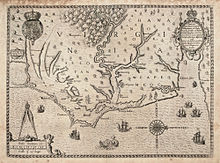Ethnic group
 1585 map by Theodor de Bry with Cwareuuoc village in top left corner along Neuse River 1585 map by Theodor de Bry with Cwareuuoc village in top left corner along Neuse River | |
| Total population | |
|---|---|
| extinct as a tribe merged into the Tuscaroras | |
| Regions with significant populations | |
| North Carolina | |
| Languages | |
| Iroquois (possibly Tuscarora dialect) | |
| Religion | |
| Native American | |
| Related ethnic groups | |
| Tuscarora |
The Coree were a very small Native American tribe, who once occupied a coastal area south of the Neuse River in southeastern North Carolina in the area now covered by Carteret and Craven counties. Early 20th-century scholars were unsure of what language they spoke, but the coastal areas were mostly populated by Iroquois and Algonquian peoples.
Name
The Coree were also called the Connamox, Cores, Corennines, Connamocksocks, Coranine Indians, and Neuse River Indians. The name Coree may be the singular form of the Carolina Algonquian name Cwareuuoc.
History
The Coree were not described by English colonists until 1701, by which time their population had already been reduced to as few as 125 members, likely due to epidemics of infectious disease and warfare. In the early 18th century, the Coree and several other tribes were allied with the Iroquoian Tuscarora against the colonists. In 1711, they participated in the Tuscarora War, trying to drive out the English settlers. The Native Americans were unsuccessful and suffered many fatalities.
By 1715, surviving Coree merged with the remaining members of the nearby Algonquian-speaking Machapunga and settled in their single village of Mattamuskeet in present-day Hyde County. This was on the shore of Lake Mattamuskeet.
The Coree soon left the Machapunga and joined the Tuscaroras.
Language
| Coree | |
|---|---|
| Region | Carolina |
| Extinct | 18th century |
| Language family | unclassified |
| Language codes | |
| ISO 639-3 | None (mis) |
| Linguist List | 075 |
| Glottolog | None |
The ethnographer James Mooney speculated that the Coree were related to the Iroquoian-speaking Cherokee, but he did not have convincing evidence. According to limited colonial reports, they spoke a language that did not appear to be mutually intelligible with any of the three major language stocks (Carolina Algonquian, Iroquoian Tuscarora, and Waccamaw Siouan or Woccon) to John Lawson, who described Coree after recording vocabularies of the other three.
On the other hand, the Coree occupied territory that was historically mostly that of Tuscaroras, which suggests they were affiliated with these peoples, whom they ultimately merged into.
References
- ^ Rountree, Helen C. (2021). Manteo's World: World Native American Life in Carolina's Sound Country Before and After the Lost Colony. Chapel Hill: University of North Carolina Press. p. 129. ISBN 9781469662947.
- Mook, Maurice A. (June 15, 1944). "Algonquian Ethnohistory of the Carolina Sound". Journal of the Washington Academy of Sciences. 34 (6): 181–228. Archived from the original on September 1, 2015. Retrieved June 30, 2014.
- ^ Coree Indian Tribe, in Frederick Webb Hodge, Handbook of American Indians North of Mexico, Washington, DC: Smithsonian Institution, 1906, carried on Access Genealogy, accessed Mar 18, 2010
- ^ Hodge, Handbook of American Indians North of Mexico, p. 349.
- Handbook of North American Indians (2004, ISBN 0160723000)
Bibliography
- Hodge, Frederick Webb (1912). Handbook of American Indians North of Mexico. Washington, D.C.: U.S. Government Printing Office.
- Ives Goddard. (2005). "The Indigenous Languages of the Southeast", Anthropological Linguistics, 47 (1), 1–60.
- Ruth Y. Wetmore (1975), "First on the Land: The North Carolina Indians" .